The Removal of Cr(VI) from Aqueous Solutions with Corn Stalk Biochar
Abstract
1. Introduction
2. Materials and Methods
2.1. Elemental Composition of Biochar
2.2. Specific Surface Area of Biochar
2.3. Preparation of Cr(VI) Solutions
R2 = 0.9927
2.4. Adsorption Experimental Design
2.5. Response Surface Design
3. Results and Discussions
3.1. The Properties of Biochar
3.2. Effect of Biochar Concentration on Cr(VI) Removal
3.3. Effect of Contact Time on Cr(VI) Removal
3.4. Effect of Cr(VI) Concentration on Cr(VI) Removal
3.5. Effect of pH on Cr(VI) Removal
3.6. Optimization of Cr(VI) Adsorption Process by Biochar
4. Conclusions
Author Contributions
Funding
Institutional Review Board Statement
Informed Consent Statement
Data Availability Statement
Conflicts of Interest
References
- Jaishankar, M.; Tseten, T.; Anbalagan, N.; Mathew, B.B.; Beeregowda, K.N. Toxicity, mechanism and health effects of some heavy metals. Interdiscip. Toxicol. 2014, 7, 60–72. [Google Scholar] [CrossRef]
- Jiang, N.; Schwarz, W.H.; Li, J. Theoretical studies on hexanuclear oxometalates [M6L19](q-) (M = Cr, Mo, W, Sg, Nd, U). electronic structures, oxidation states, aromaticity, and stability. Inorg. Chem. 2015, 54, 7171–7180. [Google Scholar] [CrossRef]
- Mishra, S.; Bharagava, R.N. Toxic and genotoxic effects of hexavalent chromium in environment and its bioremediation strategies. Journal of Environmental Science and Health Part C-Environmental. Carcinog. Ecotoxicol.Rev. 2016, 34, 1–32. [Google Scholar] [CrossRef]
- Malaviya, P.; Singh, A. Physicochemical Technologies for Remediation of Chromium-Containing Waters and Wastewaters. Crit. Rev. Environ. Sci. Technol. 2011, 41, 1111–1172. [Google Scholar] [CrossRef]
- Dhal, B.; Thatoi, H.N.; Das, N.N.; Pandey, B.D. Chemical and microbial remediation of hexavalent chromium from contaminated soil and mining/metallurgical solid waste: A review. J. Hazard. Mater. 2013, 250, 272–291. [Google Scholar] [CrossRef]
- Jin, W.; Du, H.; Zheng, S.; Zhang, Y. Electrochemical processes for the environmental remediation of toxic Cr(VI): A review. Electrochim. Acta 2016, 191, 1044–1055. [Google Scholar] [CrossRef]
- Zhang, X.; Fu, W.; Yin, Y.; Chen, Z.; Qiu, R.; Simonnot, M.-O.; Wang, X. Adsorption-reduction removal of Cr(VI) by tobacco petiole pyrolytic biochar: Batch experiment, kinetic and mechanism studies. Bioresour. Technol. 2018, 268, 149–157. [Google Scholar] [CrossRef]
- Zhang, Q.-C.; Wang, C.-C.; Cheng, J.-H.; Zhang, C.-L.; Yao, J.-J. Removal of Cr (VI) by Biochar Derived from Six Kinds of Garden Wastes: Isotherms and Kinetics. Materials 2021, 14, 3243. [Google Scholar] [CrossRef]
- Ma, Y.; Liu, W.-J.; Zhang, N.; Li, Y.-S.; Jiang, H.; Sheng, G.-P. Polyethylenimine modified biochar adsorbent for hexavalent chromium removal from the aqueous solution. Bioresour. Technol. 2014, 169, 403–408. [Google Scholar] [CrossRef]
- Zhou, L.; Liu, Y.; Liu, S.; Yin, Y.; Zeng, G.; Tan, X.; Hu, X.; Hu, X.; Jiang, L.; Ding, Y.; et al. Investigation of the adsorption-reduction mechanisms of hexavalent chromium by ramie biochars of different pyrolytic temperatures. Bioresour. Technol. 2016, 218, 351–359. [Google Scholar] [CrossRef]
- Nasseh, N.; Taghavi, L.; Barikbin, B.; Harifi-Mood, A.R. The removal of Cr(VI) from aqueous solution by almond green hull waste material: Kinetic and equilibrium studies. J. Water Reuse Desalination 2016, 7, 449–460. [Google Scholar] [CrossRef]
- Hu, X.; Song, J.; Wang, H.; Zhang, W.; Wang, B.; Lyu, W.; Wang, Q.; Liu, P.; Chen, L.; Xing, J. Adsorption of Cr(VI) and Cu(II) from aqueous solutions by biochar derived from Chaenomeles sinensis seed. Water Sci. Technol. 2019, 80, 2260–2272. [Google Scholar] [CrossRef]
- Kokab, T.; Ashraf, H.S.; Shakoor, M.B.; Jilani, A.; Ahmad, S.R.; Majid, M.; Ali, S.; Farid, N.; Alghamdi, R.A.; Al-Quwaie, D.A.H.; et al. Effective Removal of Cr(VI) from Wastewater Using Biochar Derived from Walnut Shell. Int. J. Environ. Res. Public Health 2021, 18, 9670. [Google Scholar] [CrossRef]
- Penido, E.S.; de Oliveira, M.A.; Sales, A.L.R.; Ferrazani, J.C.; Magalhães, F.; Bianchi, M.L.; Melo, L.C.A. Biochars produced from various agro-industrial by-products applied in Cr(VI) adsorption-reduction processes. J. Environ. Sci. Health Part A 2021, 56, 1387–1396. [Google Scholar] [CrossRef]
- Ahmad, M.; Rajapaksha, A.U.; Lim, J.E.; Zhang, M.; Bolan, N.; Mohan, D.; Vithanage, M.; Lee, S.S.; Ok, Y.S. Biochar as a sorbent for contaminant management in soil and water: A review. Chemosphere 2014, 99, 19–33. [Google Scholar] [CrossRef]
- Wei, J.; Tu, C.; Yuan, G.; Liu, Y.; Bi, D.; Xiao, L.; Lu, J.; Theng, B.K.; Wang, H.; Zhang, L.; et al. Assessing the effect of pyrolysis temperature on the molecular properties and copper sorption capacity of a halophyte biochar. Environ. Pollut. 2019, 251, 56–65. [Google Scholar] [CrossRef]
- Wei, S.; Zhu, M.; Fan, X.; Song, J.; Peng, P.; Li, K.; Jia, W.; Song, H. Influence of pyrolysis temperature and feedstock on carbon fractions of biochar produced from pyrolysis of rice straw, pine wood, pig manure and sewage sludge. Chemosphere 2018, 218, 624–631. [Google Scholar] [CrossRef]
- Jin, Y.; Zhang, M.; Jin, Z.; Wang, G.; Li, R.; Zhang, X.; Liu, X.; Qu, J.; Wang, H. Characterization of biochars derived from various spent mushroom substrates and evaluation of their adsorption performance of Cu(II) ions from aqueous solution. Environ. Res. 2021, 196, 110323. [Google Scholar] [CrossRef]
- Jing, Y.; Li, Z.; Li, Y.; Lei, G.; Li, L.; Yang, X.; Zhang, Z.; Yang, W. The Ability of Edible Fungi Residue to Remove Lead in Wastewater. Front. Environ. Sci. 2021, 9, 723087. [Google Scholar] [CrossRef]
- Liu, Z.; Yang, S.; Zhang, L.; Zeng, J.; Tian, S.; Lin, Y. The removal of Pb2+ from aqueous solution by using navel orange peel biochar supported graphene oxide: Characteristics, response surface methodology, and mechanism. Int. J. Environ. Res. Public Health 2022, 19, 4790. [Google Scholar] [CrossRef]
- Zhang, Y.; Duan, X. Chemical precipitation of heavy metals from wastewater by using the synthetical magnesium hydroxy carbonate. Water Sci.Technol. 2020, 81, 1130–1136. [Google Scholar] [CrossRef]
- Jiang, C.; Sun, G.; Zhou, Z.; Bao, Z.; Lang, X.; Pang, J.; Sun, Q.; Li, Y.; Zhang, X.; Feng, C.; et al. Optimization of the preparation conditions of thermo-sensitive chitosan hydrogel in heterogeneous reaction using response surface methodology. Int. J. Biol.Macromol. 2019, 121, 293–300. [Google Scholar] [CrossRef]
- Hadrich, F.; Geißen, S.-U.; Chamkha, M.; Sayadi, S. Optimizing the Extraction Conditions of Hydroxytyrosol from Olive Leaves Using a Modified Spherical Activated Carbon: A New Experimental Design. BioMed Res. Int. 2022, 2022, 6199627. [Google Scholar] [CrossRef]
- Al-Jubouri, S.M.; Curry, N.A.; Holmes, S.M. Hierarchical porous structured zeolite composite for removal of ionic contaminants from waste streams and effective encapsulation of hazardous waste. J. Hazard. Mater. 2016, 320, 241–251. [Google Scholar] [CrossRef]
- Nasseh, N.; Khosravi, R.; Rumman, G.A.; Ghadirian, M.; Eslami, H.; Khoshnamvand, M.; Al-Musawi, T.J.; Khosravi, A. Adsorption of Cr(VI) ions onto powdered activated carbon synthesized from Peganum harmala seeds by ultrasonic waves activation. Environ. Technol. Innov. 2021, 21, 101277. [Google Scholar] [CrossRef]
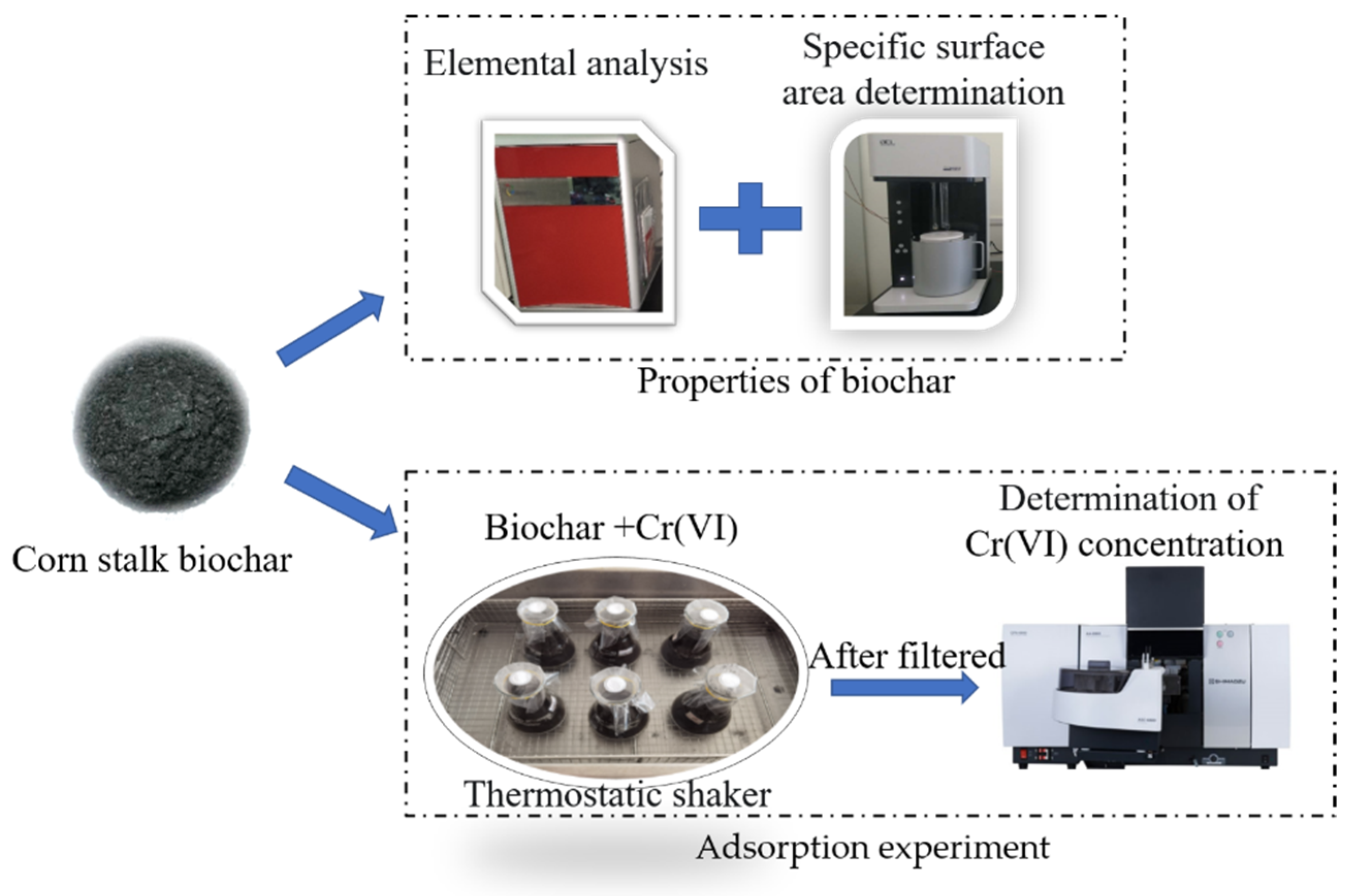
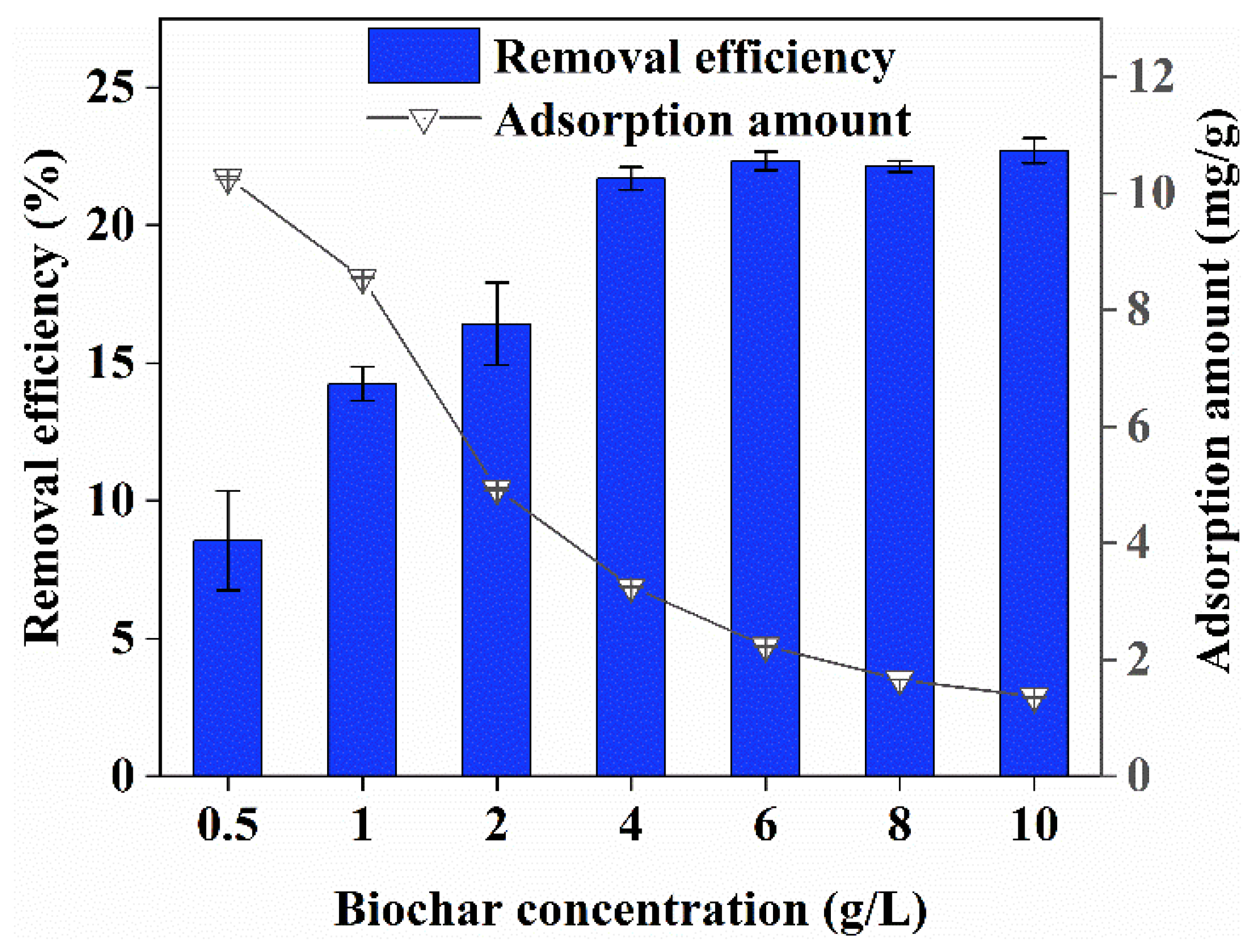
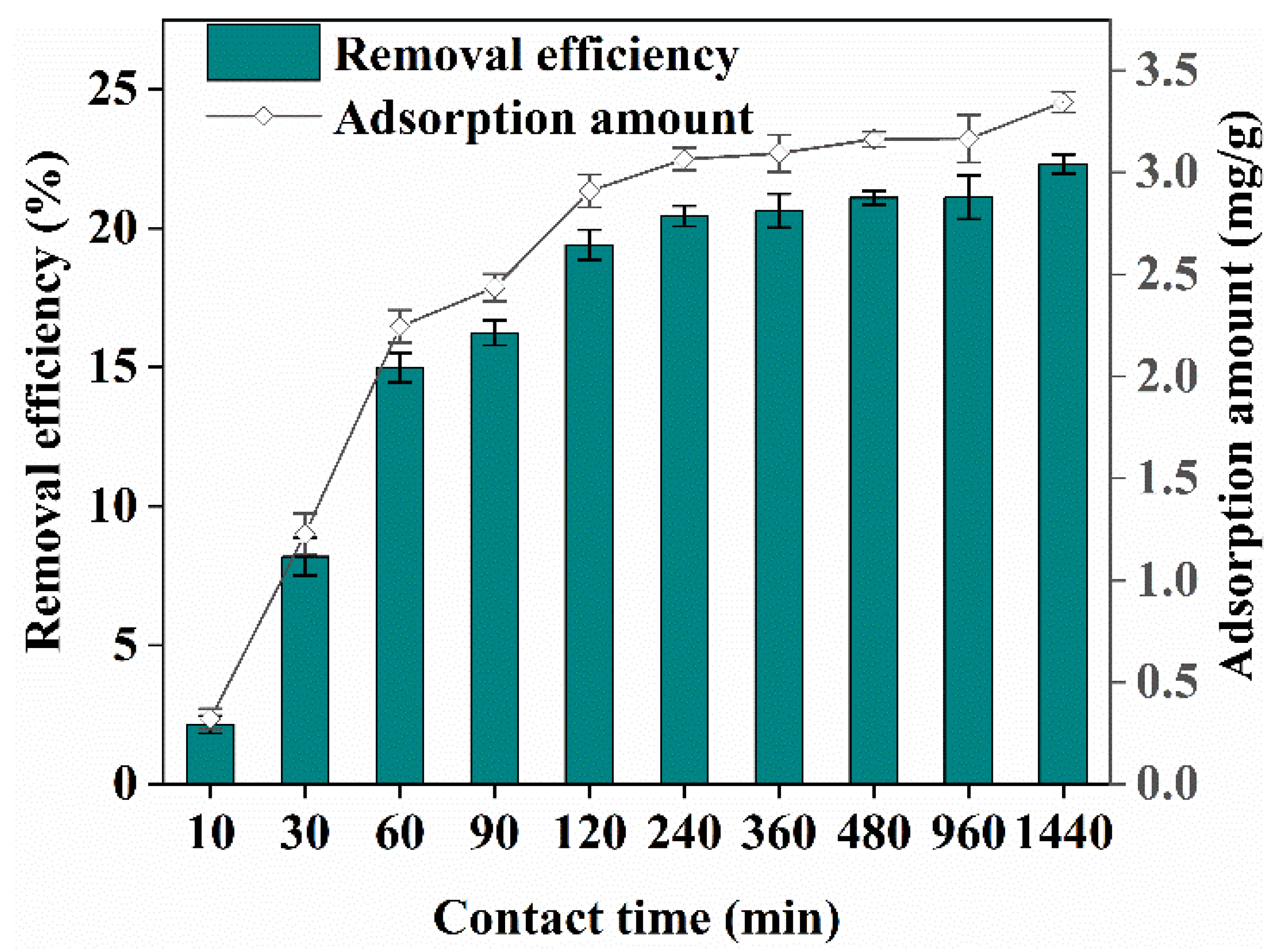
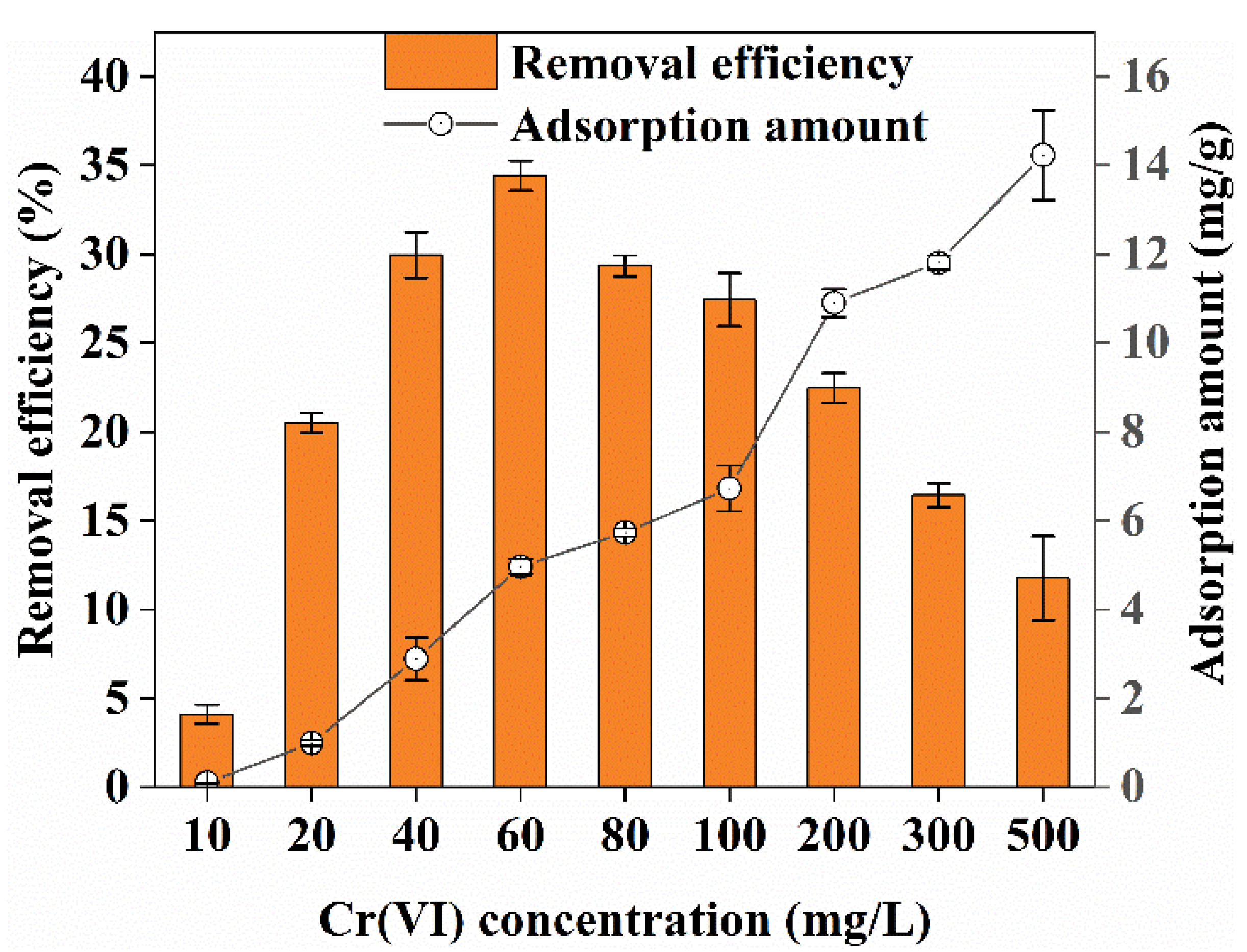

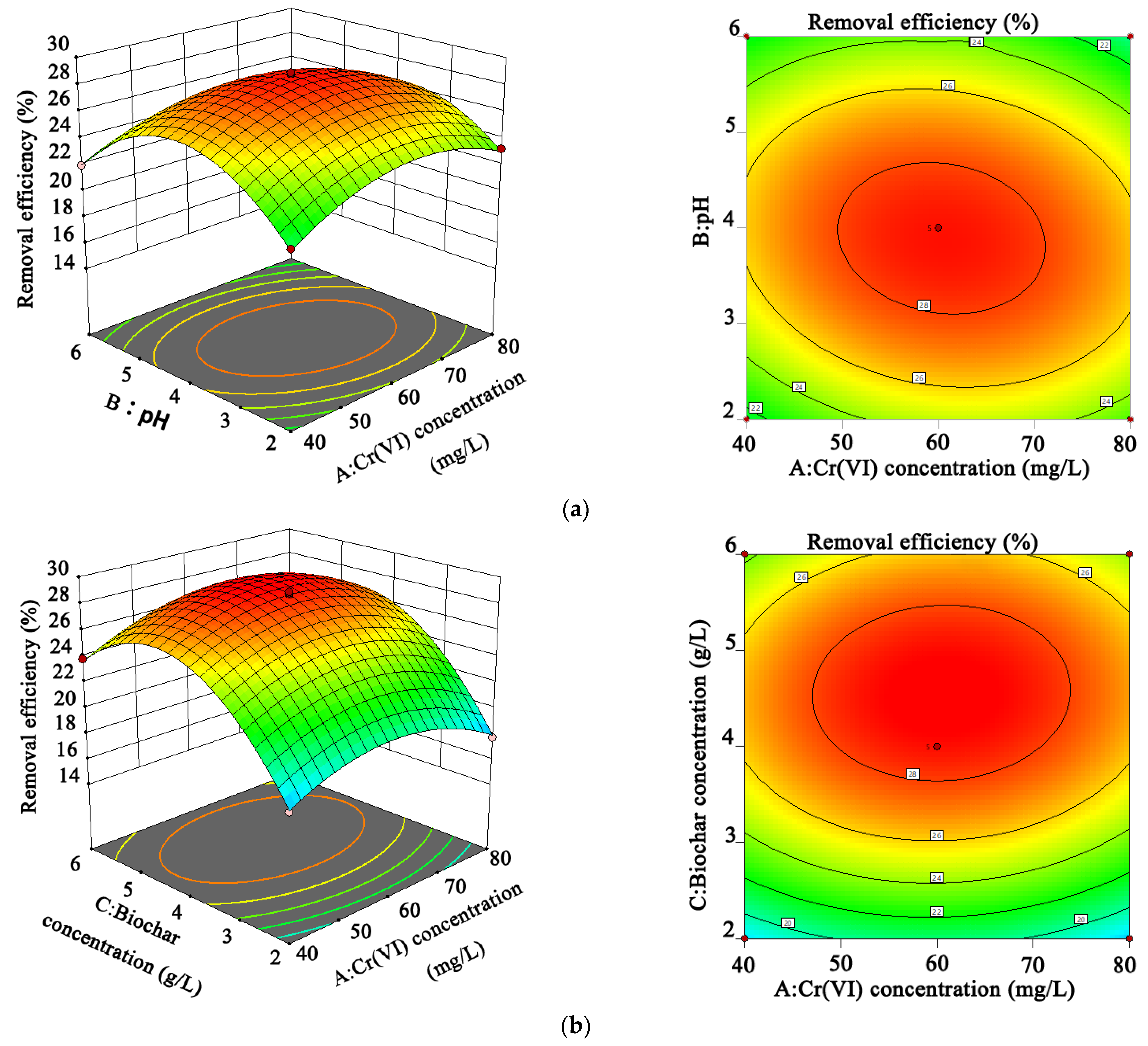
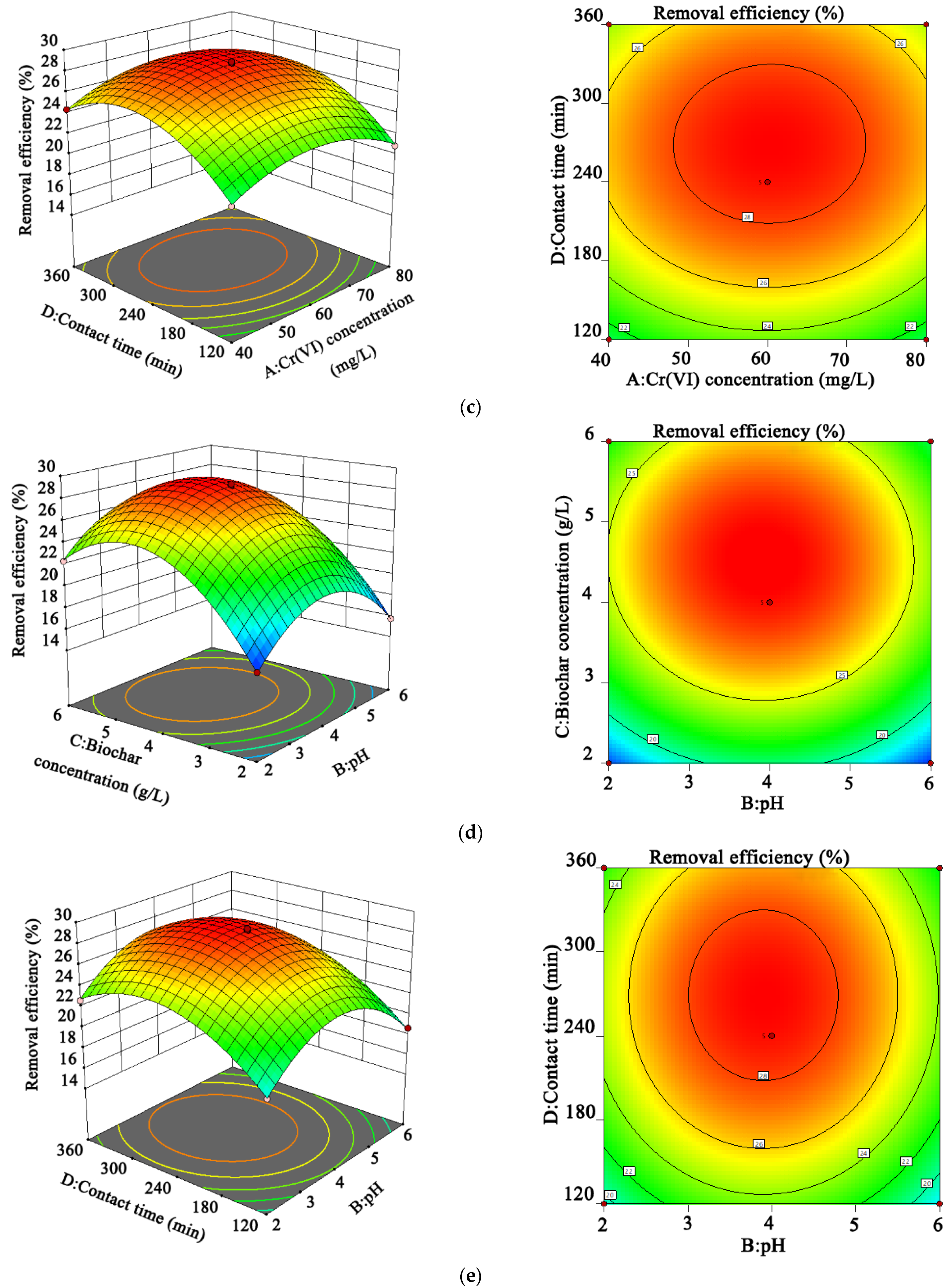

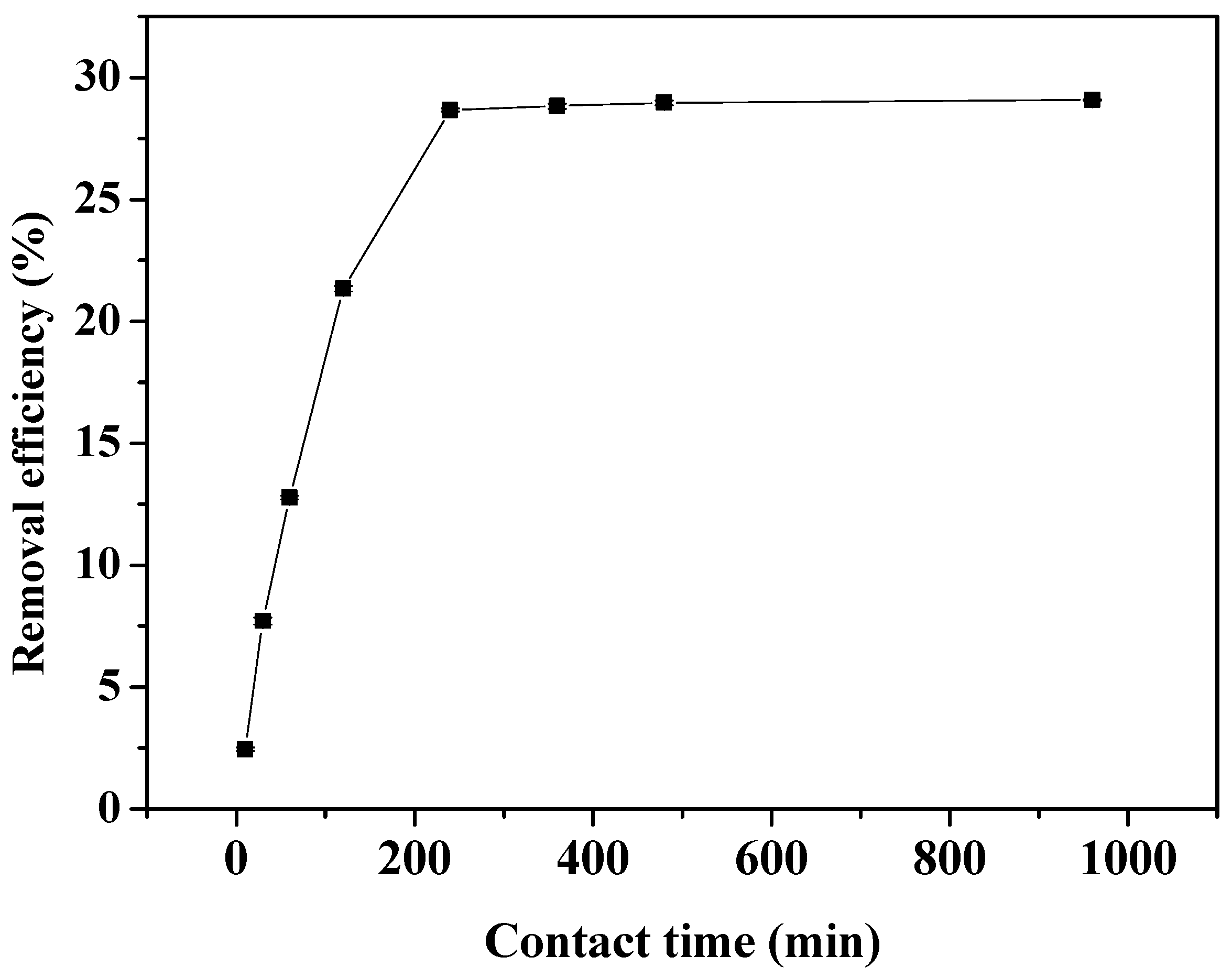
| Code | Variables | Unit | Low Level (−1) | High Level (+1) |
|---|---|---|---|---|
| A | Cr(VI) concentration | mg/L | 40 | 80 |
| B | pH | 2 | 6 | |
| C | Biochar concentration | (g/L) | 2 | 6 |
| D | Contact time | (min) | 120 | 360 |
| Code | Cr(VI) Concentration (mg/L) | pH | Biochar Concentration (g/L) | Contact Time (min) | R (%) | ||||
|---|---|---|---|---|---|---|---|---|---|
| A | Coded | B | Coded | C | Coded | D | Coded | ||
| 1 | 60 | 0 | 6 | +1 | 2 | −1 | 240 | 0 | 15.72 |
| 2 | 60 | 0 | 4 | 0 | 4 | 0 | 240 | 0 | 28.69 |
| 3 | 80 | +1 | 4 | 0 | 6 | +1 | 240 | 0 | 24.38 |
| 4 | 60 | 0 | 4 | 0 | 6 | +1 | 360 | +1 | 24.55 |
| 5 | 60 | 0 | 4 | 0 | 4 | 0 | 240 | 0 | 28.75 |
| 6 | 80 | +1 | 6 | +1 | 4 | 0 | 240 | +1 | 20.58 |
| 7 | 60 | 0 | 6 | +1 | 4 | 0 | 360 | +1 | 21.99 |
| 8 | 60 | 0 | 2 | −1 | 4 | 0 | 360 | +1 | 22.65 |
| 9 | 40 | −1 | 4 | 0 | 4 | 0 | 120 | −1 | 20.98 |
| 10 | 60 | 0 | 2 | −1 | 2 | −1 | 240 | 0 | 16.42 |
| 11 | 60 | 0 | 6 | +1 | 6 | +1 | 240 | 0 | 21.02 |
| 12 | 60 | 0 | 4 | 0 | 4 | 0 | 240 | 0 | 28.31 |
| 13 | 60 | 0 | 2 | −1 | 6 | +1 | 240 | 0 | 22.33 |
| 14 | 40 | −1 | 6 | +1 | 4 | 0 | 240 | 0 | 21.98 |
| 15 | 80 | +1 | 4 | 0 | 2 | −1 | 240 | 0 | 17.73 |
| 16 | 60 | 0 | 4 | 0 | 4 | 0 | 240 | 0 | 28.78 |
| 17 | 40 | −1 | 4 | 0 | 4 | 0 | 360 | +1 | 24.37 |
| 18 | 60 | 0 | 2 | −1 | 4 | 0 | 120 | −1 | 19.40 |
| 19 | 60 | 0 | 4 | 0 | 2 | −1 | 120 | −1 | 15.56 |
| 20 | 80 | +1 | 4 | 0 | 4 | 0 | 360 | +1 | 24.61 |
| 21 | 60 | 0 | 4 | 0 | 6 | +1 | 120 | −1 | 21.25 |
| 22 | 60 | 0 | 4 | 0 | 4 | 0 | 240 | 0 | 28.87 |
| 23 | 80 | +1 | 4 | 0 | 4 | 0 | 120 | −1 | 20.87 |
| 24 | 60 | 0 | 6 | +1 | 4 | 0 | 120 | −1 | 18.68 |
| 25 | 40 | −1 | 2 | −1 | 4 | 0 | 240 | 0 | 21.56 |
| 26 | 80 | +1 | 2 | −1 | 4 | 0 | 240 | 0 | 23.25 |
| 27 | 60 | 0 | 4 | 0 | 2 | −1 | 360 | +1 | 18.89 |
| 28 | 40 | −1 | 4 | 0 | 6 | +1 | 240 | 0 | 23.84 |
| 29 | 40 | −1 | 4 | 0 | 2 | −1 | 240 | 0 | 18.25 |
| Source | Sum of Squares | Degree Freedom | Mean Square | F-Value | p-Value |
|---|---|---|---|---|---|
| Model | 429.26 | 14 | 30.66 | 705.60 | <0.0001 |
| A | 0.0161 | 1 | 0.0161 | 0.3713 | 0.5521 |
| B | 2.65 | 1 | 2.65 | 61.00 | <0.0001 |
| C | 100.92 | 1 | 100.92 | 2322.42 | <0.0001 |
| D | 34.41 | 1 | 34.41 | 791.82 | <0.0001 |
| AB | 2.39 | 1 | 2.39 | 54.93 | <0.0001 |
| AC | 0.2809 | 1 | 0.2809 | 6.46 | 0.0235 |
| AD | 0.0306 | 1 | 0.0306 | 0.7048 | 0.4153 |
| BC | 0.0930 | 1 | 0.0930 | 2.14 | 0.1655 |
| BD | 0.0009 | 1 | 0.0009 | 0.0207 | 0.8876 |
| CD | 0.0002 | 1 | 0.0002 | 0.0052 | 0.9437 |
| A2 | 37.65 | 1 | 37.65 | 866.37 | <0.0001 |
| B2 | 132.03 | 1 | 132.03 | 3038.41 | <0.0001 |
| C2 | 176.52 | 1 | 176.52 | 4062.17 | <0.0001 |
| D2 | 78.74 | 1 | 78.74 | 1812.05 | <0.0001 |
| Residual | 0.6084 | 14 | 0.0435 | ||
| Lack of fit | 0.4204 | 10 | 0.0420 | 0.8944 | 0.5991 |
| Pure error | 0.1880 | 4 | 0.0470 | ||
| Cor total | 429.87 | 28 |
Publisher’s Note: MDPI stays neutral with regard to jurisdictional claims in published maps and institutional affiliations. |
© 2022 by the authors. Licensee MDPI, Basel, Switzerland. This article is an open access article distributed under the terms and conditions of the Creative Commons Attribution (CC BY) license (https://creativecommons.org/licenses/by/4.0/).
Share and Cite
Yang, W.; Lei, G.; Quan, S.; Zhang, L.; Wang, B.; Hu, H.; Li, L.; Ma, H.; Yin, C.; Feng, F.; et al. The Removal of Cr(VI) from Aqueous Solutions with Corn Stalk Biochar. Int. J. Environ. Res. Public Health 2022, 19, 14188. https://doi.org/10.3390/ijerph192114188
Yang W, Lei G, Quan S, Zhang L, Wang B, Hu H, Li L, Ma H, Yin C, Feng F, et al. The Removal of Cr(VI) from Aqueous Solutions with Corn Stalk Biochar. International Journal of Environmental Research and Public Health. 2022; 19(21):14188. https://doi.org/10.3390/ijerph192114188
Chicago/Turabian StyleYang, Wenling, Gao Lei, Shujing Quan, Longfei Zhang, Baitao Wang, Hong Hu, Liangliang Li, Huan Ma, Chaohui Yin, Fei Feng, and et al. 2022. "The Removal of Cr(VI) from Aqueous Solutions with Corn Stalk Biochar" International Journal of Environmental Research and Public Health 19, no. 21: 14188. https://doi.org/10.3390/ijerph192114188
APA StyleYang, W., Lei, G., Quan, S., Zhang, L., Wang, B., Hu, H., Li, L., Ma, H., Yin, C., Feng, F., & Jing, Y. (2022). The Removal of Cr(VI) from Aqueous Solutions with Corn Stalk Biochar. International Journal of Environmental Research and Public Health, 19(21), 14188. https://doi.org/10.3390/ijerph192114188







